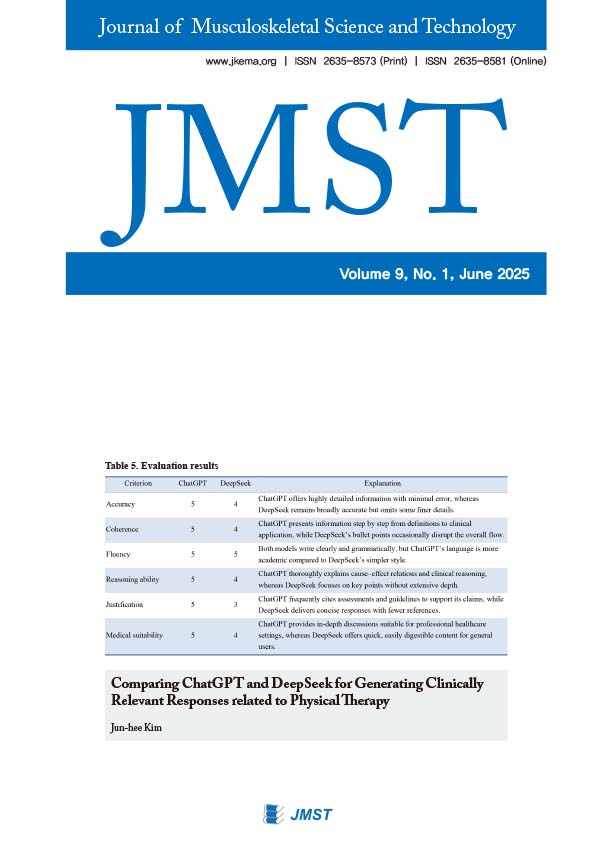The Effects of Wall Squat Exercise using Elastic Band on Leg Strength, Gait, and Plantar Pressure in Chronic Stroke Patients
이용수 0
- 영문명
- 발행기관
- KEMA학회
- 저자명
- Min-Kyoung So Tae-ho Kim
- 간행물 정보
- 『Journal of Musculoskeletal Science and Technology』제9권 제1호, 95~103쪽, 전체 9쪽
- 주제분류
- 의약학 > 재활의학
- 파일형태
- 발행일자
- 2025.06.30
구매일시로부터 72시간 이내에 다운로드 가능합니다.
이 학술논문 정보는 (주)교보문고와 각 발행기관 사이에 저작물 이용 계약이 체결된 것으로, 교보문고를 통해 제공되고 있습니다.

국문 초록
영문 초록
목차
해당간행물 수록 논문
- Effects of Shoulder Horizontal Abduction with Thoracic Extension on Electromyography of Trapezius Muscles
- Supervised Machine Learning for Frailty Classification using Physical Performance Measures in Older Adults
- The Analysis of Gait Variables and Plantar Pressure Patterns in Community-Dwelling Elderly Patients with Hemiplegic Stroke
- Correlation Analysis between Shoulder Abduction Angles and Normalized Muscle Activity of Scapular Muscles during Y-Raise Exercise with Elastic Resistance
- Effects of a Hip Joint Muscle Strengthening Program using Props on Lower Limb Alignment and Balance in Older Adults
- Relationships among Sleep Quality, Postural Alignment, Muscle Strength, and Psychological Health in Healthy Adults
- Effects of Hip Joint Closed Kinetic Chain Exercises on Static and Dynamic Balance according to Support Surface in Physical Education Entrance Exam Students with Functional Ankle Instability
- Effects of Sit-to-Stand Exercise combined with Joint Mobilization with Movement on Lower Extremity Functions, Balance, and Gait Performance in Patients with Chronic Stroke
- The Effects of Wall Squat Exercise using Elastic Band on Leg Strength, Gait, and Plantar Pressure in Chronic Stroke Patients
- Comparative Effects of Leaflet- and Video-Guided Core Stabilization Exercises on Juvenile Idiopathic Scoliosis
- Influences of Metatarsal Toe Orthosis on 3D Kinematic Pelvic Motion during Gait in Individuals with Morton Foot Syndrome
- Comparing ChatGPT and DeepSeek for Generating Clinically Relevant Responses related to Physical Therapy
- Comparison of Gluteus Maximus, Biceps Femoris, and Multifidus Muscle Activity and Heart Rate Variability between Bridge and Sling Bridge Exercises in Individuals with Non-Specific Low Back Pain
참고문헌
관련논문
의약학 > 재활의학분야 BEST
- 중증정신질환자가 이용하는 지역사회 정신건강서비스에 대한 체계적 고찰
- 인지행동치료가 조현병 환자의 자아존중감에 미치는 영향에 대한 체계적 고찰
- 조현병 환자에게 적용한 그룹인지재활프로그램이 인지기능과 작업적 참여에 미치는 효과
의약학 > 재활의학분야 NEW
- Effects of Shoulder Horizontal Abduction with Thoracic Extension on Electromyography of Trapezius Muscles
- Supervised Machine Learning for Frailty Classification using Physical Performance Measures in Older Adults
- The Analysis of Gait Variables and Plantar Pressure Patterns in Community-Dwelling Elderly Patients with Hemiplegic Stroke
최근 이용한 논문
신규가입 혜택 지급이 완료 되었습니다.
바로 사용 가능한 교보e캐시 1,000원 (유효기간 7일)
지금 바로 교보eBook의 다양한 콘텐츠를 이용해 보세요!




